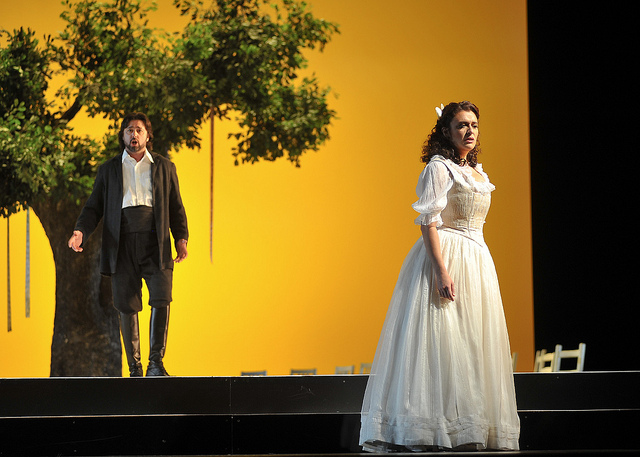
Spanish opera and a rare instrument
It’s a weekend for the slightly unusual, beginning with Florida Grand Opera’s first-ever mounting of a zarzuela, and a quirky recital program Sunday that features a beautiful instrument that hardly anyone plays.Zarzuela is Spanish operetta, meaning that it features spoken dialogue between musical numbers, much like the American musical (which itself descends from Viennese operetta). Although the form has its origins in the 17th century, it’s usually the zarzuelas written during a revival of the genre starting in the mid-19th century that we hear today. There were many fine Spanish composers who tried their hand at the form, and last week, the Miami Lyric Opera presented Emiliano Arrieta’s “Marina“ (in the grand-opera version Arrieta devised from his original zarzuela).
Tonight, Florida Grand presents “Luisa Fernanda,” written in 1937 by Federico Moreno Torroba, and this is the zarzuela that’s often considered the masterpiece of the form. It has an interesting political plot, set in the Spain of 1868, the year of the Glorious Revolution that overthrew Queen Isabella II. Musically, it’s quite pleasant, with a Romantic score that wouldn’t have been out of place in the 1860s.
Here’s Placido Domingo singing “Ay, mi morena,” from Act III of the Madrid Teatro Real production that Florida Grand Opera is using for its own show. He’ll be here to sing this role Tuesday for a one-night-only gala, which is like receiving a blessing from the god of zarzuela for the production. It was Domingo who suggested to Florida Grand Opera’s Robert Heuer that “Luisa Fernanda” would be the best choice for the company’s first zarzuela.
I last saw this piece early this year in a workshop production in West Palm Beach, and even in a stripped-down setting, it had great charm and considerable appeal to a heavily Spanish-speaking audience. With Domingo on his way to boost things this Tuesday, this is likely to be a production that area audiences will embrace. The zarzuela opens tonight at 7 at the Ziff Ballet Opera House.
On Sunday afternoon, the violist Richard Fleischman, who teaches at the New World School for the Arts downtown and occupies the viola chair of the Delray String Quartet, presents a program at the Bass Museum of Art entirely devoted to the viola d’amore (the concert starts at 3 p.m.).
The viola d’amore is an unusual instrument that survives from the days when instrument makers were looking for bigger self-contained sounds and added sympathetic strings. It has 14 strings, seven above and seven underneath, that resonate when the upper ones are played. It’s a special, lovely sound, and most of the time we hear it today in music of the Baroque, though Hindemith wrote for it and so did Puccini, scoring for it as the accompaniment to the humming chorus in the night scene of “Madama Butterfly.”
(Here’s the French musician Helene Plouffe explaining the viola d’amore in a video for an album she released of music for the instrument.)
Fleischman will be joined by flutist Elissa Lakofsky, harpist Deborah Fleisher, violist Marda Todd and countertenor Jacques Snyman. The program includes music by Ariosti, Vivaldi (a movement from “Nisi Dominus“) and Martini, along with Carl Stamitz’s variations on a French tune we know better as “For He’s a Jolly Good Fellow” or “The Bear Went Over the Mountain.”
Then there’s a bunch of little-known Romantic music, including pieces by Henri Casadesus (four preludes from a set of 24), Rene de Boisdeffre (“Reverie“) and Louis van Waefelghem (“Romance“ and “Soir d’automne“). Fleischman also will play an arrangement of “The Swan,” from Camille Saint-Saens’ “Carnival of the Animals.”
But the really interesting piece might be the one just before the Saint-Saens, which Fleischman is billing as a North American premiere. It’s an anonymous concerto found in the Benedictine nunnery in Sandomierz, Poland and thought to date from about 1750. It’s been recorded by the Polish musician Artur Paciorkiewicz, and it’s a very good piece with some interesting stylistic oddities. (Here it is.)
It sounds to me like it’s somewhat later than 1750, and its slow movement is dance-inspired, somewhat like a stylized mazurka. The coloring of the orchestration is heavier on flutes, which gives it an unusual color and leads me to believe the music is probably by a Polish composer, perhaps even one of the nuns living there at the time.
My favorite guess is that it might have been written by a young Polish string player and composer who was the pride of his hometown before tuberculosis claimed him at a very early age, before he could make his mark on the world. It’s the stuff of good historical fiction, and someone out there could have fun writing a good story around it.
Most important is that it’s a fine piece of music, and while it’s a shame we don’t know who wrote it, it’s heartening to know that it will get a new performance this weekend in Miami Beach.
Recent Content
-
Artsarticle ·
-
Artsarticle ·
-
Artsarticle ·

